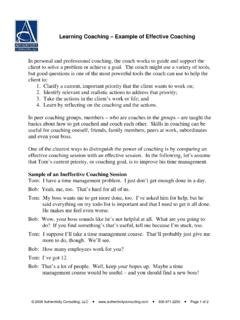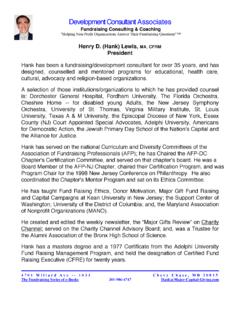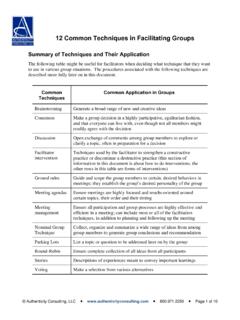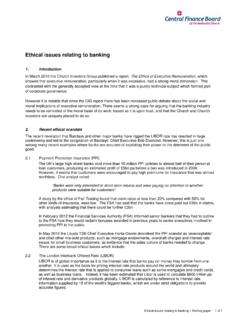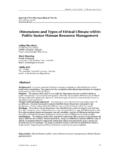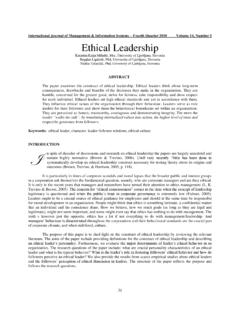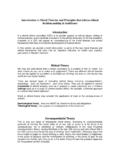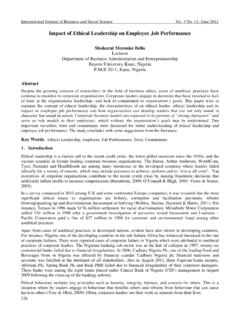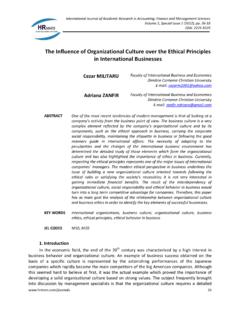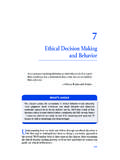Transcription of THE TEN STEP METHOD OF DECISION-MAKING THE TEN …
1 THE TEN- step METHOD OF DECISIONMAKING BACKGROUND Developed by Jon Pekel and Doug Wallace, the Ten step METHOD of Decisionmaking has five features that make it practically useful in today's highly competitive, global context, rapidly changing business environment: 1. Stakeholder Based Based on the stakeholder theory of management assumes that anyone or any entity that could be significantly affected has a RIGHT to have its best interests CONSIDERED 2. ethical Theory Based Based on (and incorporates as a check-and-balance on one another) the two most commonly used and beneficial ethical DECISION-MAKING perspectives Consequential perspective focuses on the cost/benefit affects of the decision Absolute principle perspective focuses on aligning action with universal ethical principles 3.
2 Systems Based Probes for and deals with underlying drivers that cause and exacerbate the situation. Doesn't just deal with "rotten apple issues in the barrel" Forces decisionmakers to also deal with the barrel (organizational culture and systems) itself 4. ethical Checklist Includes a simple checklist that gives the decisionmakers a numerical sense of how effective they have been in using the ethical dimensions of the decisionmaking process. 5. Designed To Be A Highly Practical Management Tool As the situation warrants, some or all of the ten steps can be used Recognizes that most serious, high-risk, high-impact issues stem from management's actions or inactions Effective in dealing with highly complex situations, including cross-cultural international business issues Also useful for non-management staff in raising and resolving ethical issues c Jon Pekel (651-734-9011) & Doug Wallace (612-333-0520)
3 [Permission is granted for the non-publication organizational use of this Ten step METHOD of DecisionMaking.] Page 1 of 13 THE TEN step METHOD OF DECISION-MAKING8/8/2006file://C:\FML Feb 19 2006\ethics\ TEN STEPS AT-A-GLANCE [Includes hints for using each step ] [Before You Get Started: Do a Preliminary ethical Assessment. Use 2 tests to determine to what degree there is a significant ethical dimension to this situation. 1) Value-conflicts. How different are the kinds of values held by different stakeholders? 2) Consequences.]
4 How significant are the possible consequences of this situation? 1. IDENTIFY THE KEY FACTS Role play key stakeholders to see what they see as facts. Watch out for assuming causative relationships among coincidental facts. 2. IDENTIFY & ANALYZE THE MAJOR STAKEHOLDERS Make sure to identify both direct and indirect stakeholders. Genuinely walk in their shoes to see what they value and want as a desired outcome. 3. IDENTIFY THE UNDERLYING DRIVING FORCES Think like a look for what s beneath the presenting symptoms.
5 Use these driving forces to develop your step 8 preventive component. 4. IDENTIFY/PRIORITIZE OPERATING VALUES & ethical PRINCIPLES Think of this step as determining the up-front design parameters for an effective solution. Don t rush this step building consensus here will pay off later. 5. DECIDE WHO SHOULD BE INVOLVED IN MAKING THE DECISION All stakeholders have a right to have their best interests considered. If you can t actually involve all stakeholders, have someone role play their point of view.
6 6. DETERMINE & EVALUATE ALL VIABLE ALTERNATIVES Critical: all possible alternatives must pass the 3-part review-gate criteria. Imagine possible consequences of each alternative cascading down on each stakeholder. 7. TEST PREFERRED ALTERNATIVE WITH A WORST-CASE SCENARIO This step helps prevent a rush to judgment towards a wrong solution. Emphasize this step when all stakeholder interests are not being adequately considered. 8. ADD A PREVENTIVE COMPONENT Problem-solving heroes want to get on to the next problem and won t take time for this step .
7 Only immediate-solution decisions usually come back to bite you. 9. DECIDE AND BUILD A SHORT & LONG-TERM ACTION-PLAN The devil s usually in the details take the time needed to be detailed and comprehensive. Make sure that the means used in your action-steps correlate with your desired ends. 10. USE DECISION-MAKING CHECKLIST Become thoroughly familiar with this end-point checklist before you get started in step 1. Don t allow group-think here -- make sure everyone involved fills this out individually.
8 Page 2 of 13 THE TEN step METHOD OF DECISION-MAKING8/8/2006file://C:\FML Feb 19 2006\ethics\ BEFORE YOU GET STARTED: DO A PRELIMINARY ethical ASSESSMENT Background. An ethical business issue is any significant business issue that has a significant ethical dimension. There are two tests to decide whether a business issue has a significant ethical dimension. If one or both apply, the situation requires use of an ethically based DECISION-MAKING process like this Ten step METHOD . The two-fold test is whether situation could possibly cause the business to knowingly or unknowingly: 1) Violate a commonly accepted ethical principle ( honesty, fairness, respect for persons) or stated business standard ( no conflicts of interest or misuse of corporate funds.
9 This definition is rooted in thenon-consequentialist, universal/absolute principle, or rule-oriented ethical perspective. 2) Inflict significant, undue, inappropriate harm on any stakeholder. A stakeholder is any individual, group, society or the natural environment that could be effected by the situation. This definition is rooted inthe consequentialist, effects, or results-oriented ethical perspective. TEST #1: DEGREE OF COMPETING VALUE-CONFLICTS -- How different are the kinds of ethical principles andoperating values held by different stakeholders?
10 Typically, the strongest value conflicts are between operating values ( make a profit) and ethical principles ( honesty). List below some of the different kindsof operating values and ethical principles/business standards that are in conflict with one another in this situation: 1) [Operating value] vs. [Principle/standard] 2) [Operating value] vs. [Principle/standard] Check the box that represents the degree of value-conflicts in this situation: TEST #2: EXTENT OF POSSIBLE HARMFUL CONSEQUENCES -- How significant are the possible harmful consequences of this situation?

